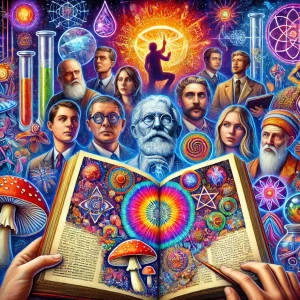 In May 1957, LIFE magazine published a groundbreaking article titled “Seeking the Magic Mushroom,” which documented the experiences of a U.S. banker, R. Gordon Wasson, who ventured into a remote Mexican village to participate in the ancient ritual of consuming psychedelic mushrooms. This article is often credited with being a catalyst for the psychedelic movement that emerged in the 1950s and 1960s, inspiring countless individuals, researchers, and cultural pioneers to explore the potential of psychedelics. Let’s explore how this article became a significant influence on the later psychedelic pioneers and why it played such a pivotal role.
In May 1957, LIFE magazine published a groundbreaking article titled “Seeking the Magic Mushroom,” which documented the experiences of a U.S. banker, R. Gordon Wasson, who ventured into a remote Mexican village to participate in the ancient ritual of consuming psychedelic mushrooms. This article is often credited with being a catalyst for the psychedelic movement that emerged in the 1950s and 1960s, inspiring countless individuals, researchers, and cultural pioneers to explore the potential of psychedelics. Let’s explore how this article became a significant influence on the later psychedelic pioneers and why it played such a pivotal role.
The Article’s Content and Its Significance
The LIFE magazine article detailed Wasson’s journey into the mountains of Oaxaca, Mexico, where he partook in a sacred indigenous ceremony involving psilocybin mushrooms. The piece described in vivid detail the effects of the mushrooms, the rituals surrounding their use, and the profound spiritual and psychological experiences reported by Wasson and the local Mazatec curandera, María Sabina, who guided him through the ceremony.
This publication marked one of the first times that the Western public was introduced to the concept of using psychedelics not as recreational drugs, but as tools for spiritual enlightenment and personal transformation. The article featured striking photographs and an engaging narrative that captured the imaginations of readers, making them curious about these “magic mushrooms” and the potential to unlock hidden aspects of human consciousness.
The Article as a Catalyst for Psychedelic Research and Experimentation
Inspiration for Researchers and Psychologists:
The article ignited a wave of interest among scientists, psychologists, and psychiatrists who were fascinated by the potential of psychedelics to treat mental health disorders and foster spiritual growth. Notable figures such as Timothy Leary, a Harvard psychologist, became interested in the potential of these substances. Leary’s reading of the article is often cited as a turning point that led him to become a prominent advocate for psychedelic research, eventually leading to his own experiments with psilocybin and LSD.
Influence on Countercultural Icons:
The article also reached the burgeoning counterculture movement, capturing the attention of writers, artists, musicians, and spiritual seekers. Figures like Aldous Huxley, Allen Ginsberg, and Ken Kesey, who were already exploring alternative states of consciousness, were further encouraged by Wasson’s documented experiences. The idea that psychedelics could provide a pathway to spiritual enlightenment resonated deeply with the ideals of the counterculture, which sought to break away from mainstream societal norms and explore new ways of living and thinking.
Popularizing the Use of Psychedelics in Spiritual Practices:
Wasson’s article contributed to the understanding of psychedelics as sacraments or spiritual tools, an idea that would later be championed by proponents like Leary and Ram Dass. The notion that these substances could provide insights into the divine, the self, and the universe aligned with the spiritual quests of the 1960s, influencing many to pursue psychedelics as part of their spiritual journeys.
Encouraging Further Exploration and Pilgrimages:
After the publication of the article, a surge of Westerners traveled to Mexico in search of these sacred mushrooms, seeking similar mystical experiences. This influx of seekers further fueled the spread of psychedelic culture, creating a cross-pollination of indigenous traditions and Western experimental practices. María Sabina, the Mazatec shaman mentioned in the article, became a well-known figure in psychedelic circles, though this attention also brought unintended consequences to her and her community.
A Foundation for Future Psychedelic Research
The 1957 LIFE article helped lay the groundwork for future psychedelic research. It played a crucial role in legitimizing the scientific study of psychedelics by bringing them into the public consciousness in a reputable and widely read publication. By doing so, it indirectly led to the establishment of early psychedelic research programs at institutions such as Harvard, Stanford, and UCLA, where researchers like Leary, Richard Alpert (later Ram Dass), and others began exploring the potential of these substances.
Legacy and Enduring Impact
Even decades later, the LIFE magazine article remains a significant point of reference for those studying the history of psychedelics. It marked a moment when Western society first began to seriously consider the use of psychedelics beyond the realm of traditional medicine and as tools for spiritual awakening and psychological healing. As the modern resurgence of interest in psychedelic therapy continues to grow, the influence of Wasson’s account in LIFE magazine can still be felt, reminding us of the curiosity and wonder that first sparked the psychedelic revolution.
The publication of “Seeking the Magic Mushroom” in LIFE magazine was more than just a sensational story; it was a catalyst that inspired a generation of researchers, spiritual seekers, and cultural icons to explore the mysteries of the human mind and spirit through psychedelics. Its impact on the psychedelic movement of the 1950s and 1960s is undeniable, laying the groundwork for a cultural shift that continues to influence us today. The article served as an invitation to explore the unknown, a call that many heeded, shaping the future of psychedelic research and the quest for spiritual enlightenment.




